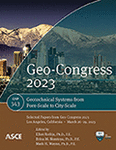Saturation-Based versus Proctor-Based Field Compaction Quality Control
Publication: Geo-Congress 2023
ABSTRACT
Field compaction control is arguably the most common yet critical quality control procedure in geotechnical engineering. Since the early 1930s, the Proctor-based process for performing quality control of compacted soils has consisted of comparing the in-place dry unit weight (or density) and in-place moisture content of the soil with a laboratory reference. However, the current practice overlooks several facts that stand out by comparing compacted soil prepared in the laboratory versus compacted soil placed in the field. These issues mainly stem from overlooking the differences in the compaction energy in the lab versus what is applied in the field, and the unsaturated nature of compacted soil in assessing compaction performance. To address some of these issues, a new saturation-based framework for compaction quality control is compared to the traditional Proctor-based with the goal of providing practicing engineers with further insight into the key engineering attributes of compacted soils. The proposed saturation-based system builds upon advances in unsaturated soil mechanics and recent studies that relate normalized dry unit weight of the as-compacted soils that can significantly reduce the variation of laboratory-prepared reference specimens. The presented comparison is developed with the same field and laboratory data collected in most earth fill projects. For illustration purposes, the saturation-based framework is applied to a case history of compaction control data for an earth dam and compared to the conventional method.
Get full access to this article
View all available purchase options and get full access to this chapter.
REFERENCES
AASHTO. AASHTO Designation: T 272-18. One-Point Method for Determining Maximum Dry Density and Optimum Moisture.” American Association of State Highway and Transportation Officials, Washington, D.C.
ASTM. ASTM D698. (2021). Standard Test Methods for Laboratory Compaction Characteristics Using Standard Effort (600 kN-m/m3). American Society of Testing and Materials (ASTM), West Conshohocken, PA.
ASTM. ASTM D1557. (2015). Standard Test Methods for Laboratory Compaction Characteristics Using Modified Effort (2,700 kN-m/m3). American Society of Testing and Materials (ASTM), West Conshohocken, PA.
Holtz, R. D., Kovacs, W. D., and Sheahan, T. C. (2011). An Introduction to Geotechnical Engineering. 2nd Ed., Pearson, Upper Saddle River, New Jersey.
Kodikara, J., Islam, T., and Sounthararajah, A. (2018). “Review of Soil Compaction: History and recent developments.” Transportation Geotechnics 17, 24–34, j.trgeo.2018.09.006.
Koerner, R. M., and Koerner, G. R. (2018). An extended database and recommendations regarding 320 failed geosynthetic reinforced mechanically stabilized earth (MSE) walls. Geotextiles and Geomembranes, 46(6), 904–912.
Liu, D. H., Sun, J., Zhong, D., and Song, L. (2012). Compaction quality control of earth-rock dam construction using real-time field operation data. J. Constr. Eng. Manage., https://doi.org/10.1061/(ASCE)CO.1943-7862.0000510, 1085–1094.
Luo, N., and Bathurst, R. J. (2018). Probabilistic analysis of reinforced slopes using RFEM and considering spatial variability of frictional soil properties due to compaction. Georisk 12 (2): 87–108. https://doi.org/10.1080/17499518.2017.1362443.
Meehan, C. L., Tehrani, F. S., and Vahedifard, F. (2012). A comparison of density-based and modulus-based in situ test measurements for compaction control. Geotechnical Testing Journal, 35(3), 387–399.
Mokwa, R. L., and Fridleifsson, S. (2005). “Soil Air Voids Method for Compaction Control.”, prepared for the State of Montana, Department of Transportation.
Noorany, I., Gardner, W. S., Corley, D. J., and Brown, J. L. (2000). Variability in Field Density Tests. Constructing and Controlling Compaction of Earth Fills, ASTM STP 1384, D. W. Shanklin, K. R. Rademacher, and J. R. Talbot, Eds, American Society for Testing and Materials, West Conshohocken, PA.
Proctor, R. R. (1933). Fundamental Principles of Soil Compaction. Engineering News-Record, New York, Volume 111, No 9, August 31, pp 55–58.
Taylor, O. D. S., Berry, W., Winters, K., Rowland, W., Antwine, M., and Cunningham, A. (2017). “Protocol for Cohesionless Sample Preparation for Physical Experimentation.” Geotechnical Testing Journal Volume 40, No. 2, March, ASTM.
Tatsuoka, F. (2015). “Compaction characteristics and physical properties of compacted soil controlled by the degree of saturation.” In Geotechnical Synergy in Buenos Aires 2015, pp. 435–471. IOS Press, doi:https://doi.org/10.3233/978-1-61499-599-9-435.
Tatsuoka, F., and Correia, A. G. (2018). Importance of controlling the degree of saturation in soil compaction linked to soil structure design, Transportation Geotechnics, 17, 3–23.
Tinjum, J. M., Benson, C. H., and Blotz, L. R. (1997). Soil-water characteristic curves for compacted clays. Journal of Geotechnical and Geoenvironmental Engineering, 123(11), 1060–1069.
Vanapalli, S. K., Fredlund, D. G., and Pufahl, D. E. (1996). The Relationship Between the Soil-Water Characteristic Curve and the Unsaturated Shear Strength of a Compacted Glacial Till, ASTM Geotechnical Testing Journal, GTJODJ, Vol 19, No3, September 1996, pp 259–268.
Wang, X., Shen, S., Huang, H., and Almeida, L. C. (2018). Characterization of particle movement in Superpave gyratory compactor at meso-scale using SmartRock sensors. Constr Build Mater 2018;175:206–14.
Information & Authors
Information
Published In
History
Published online: Mar 23, 2023
Authors
Metrics & Citations
Metrics
Citations
Download citation
If you have the appropriate software installed, you can download article citation data to the citation manager of your choice. Simply select your manager software from the list below and click Download.
Cited by
- Kevin C. Miller, Farshid Vahedifard, A New Saturation-Based Framework for Compaction Quality Control, International Journal of Geomechanics, 10.1061/IJGNAI.GMENG-9084, 24, 3, (2024).
